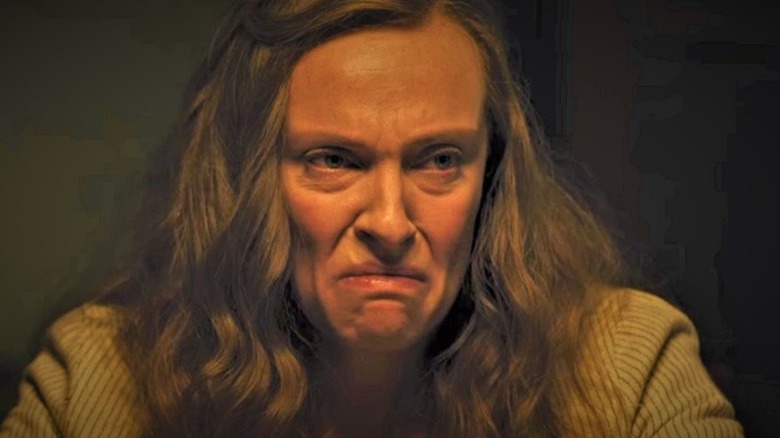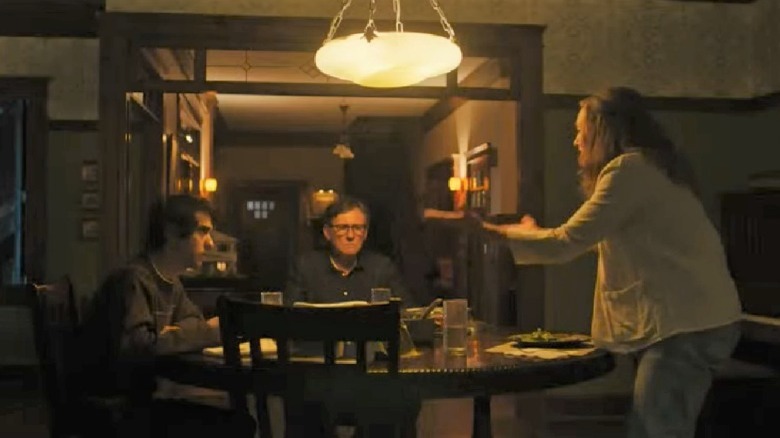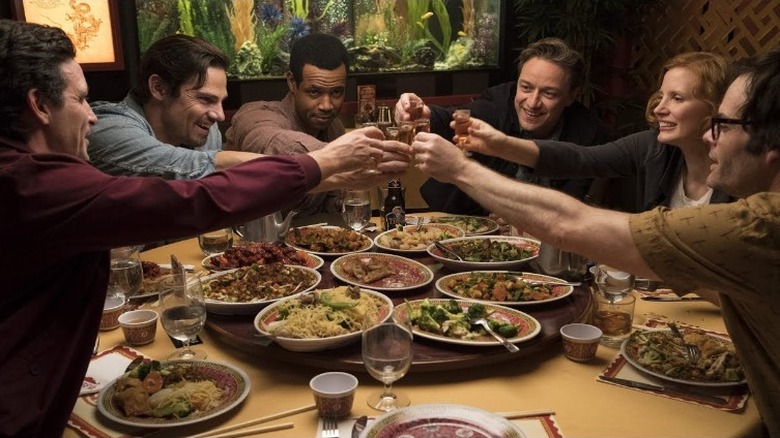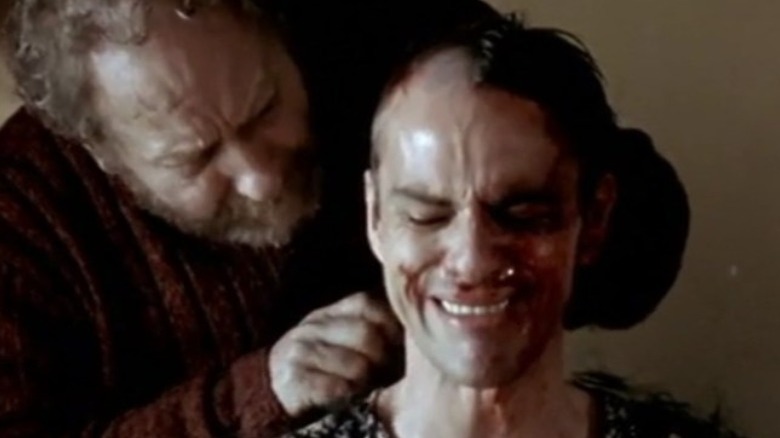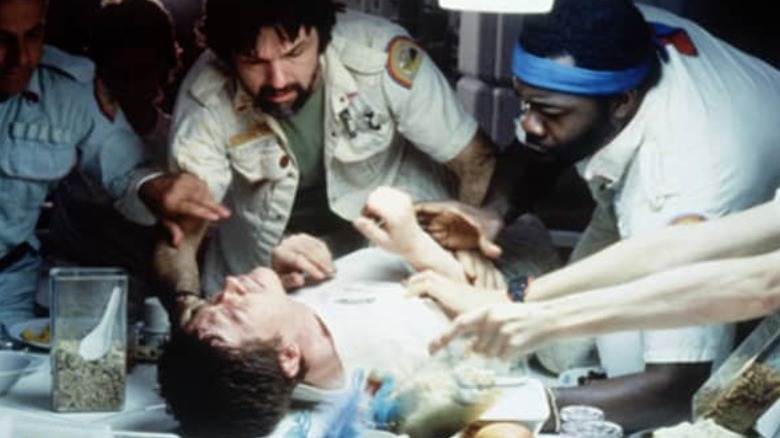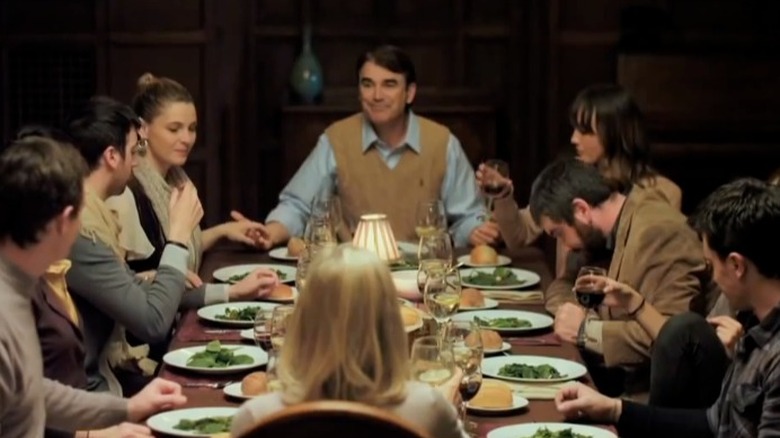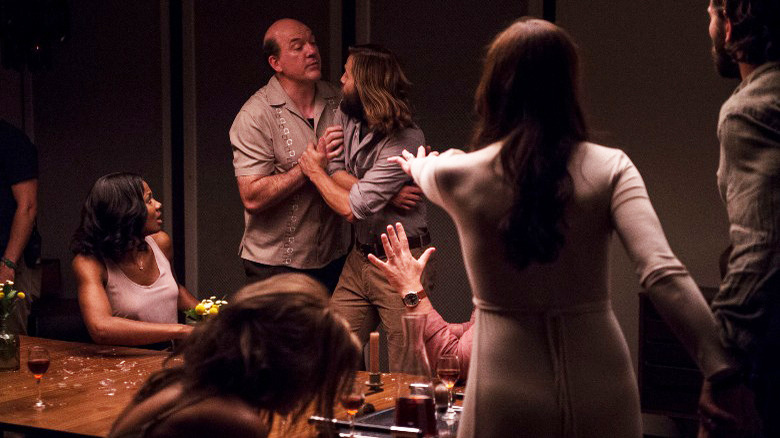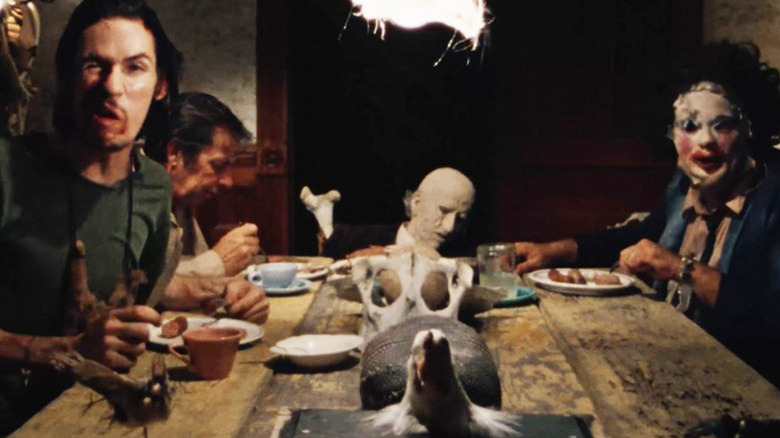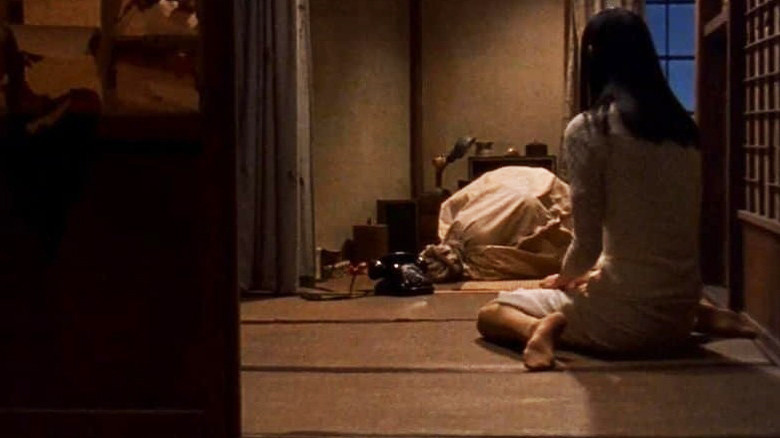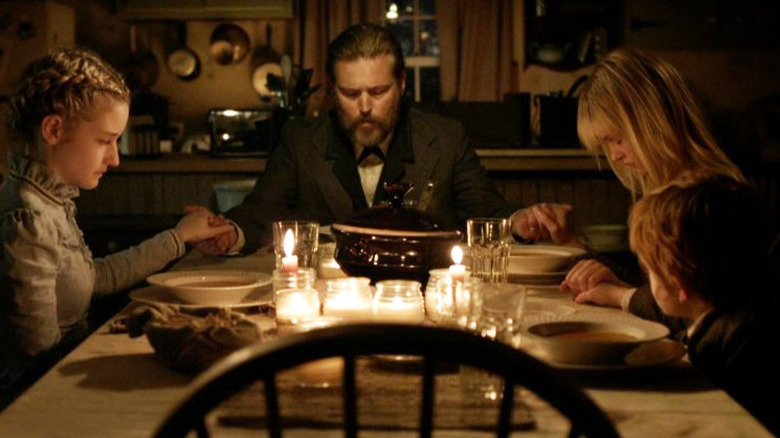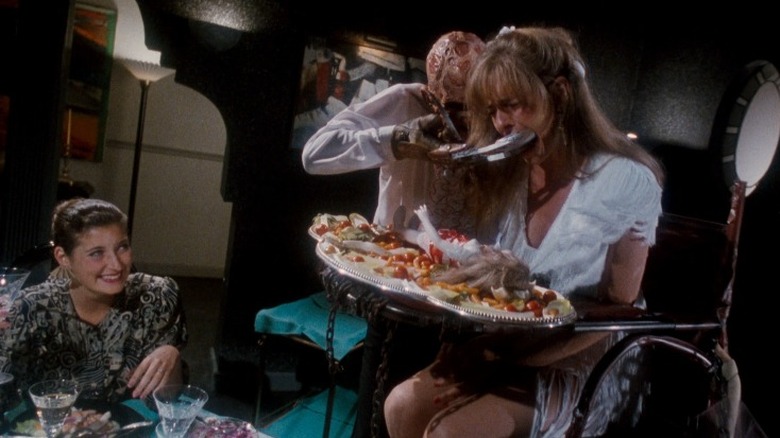The 10 Most Terrifying Dinner Scenes In Horror Movies
Everyone remembers the old Stouffer's commercials. A nice American family sits down for some kind of baked casserole or microwaved TV dinner while a soft guitar thrums in the background, urging them to reprioritize family time. In truth, it's not an especially bad sentiment. Interpersonally speaking, the dinner table is as good an opportunity as ever to connect to the people one loves most, sharing notes on respective days — the good, the bad, and everything in between.
As an opportunity to unwind and connect, it's priceless, though if horror movies have taught audiences anything, it's that the dinner table can be one of the scariest places to be. It's par for the course, with scary movies frequently exploiting quotidian fears to terrifying, remarkable success. The dinner table is perhaps one of the scariest, however, largely because it's so intimate. At the table, guards are down and closeness is elevated. It's a window into the unvarnished souls of those there, and here we'll be looking at the 10 most terrifying dinner scenes in horror movies.
Hereditary
Ari Aster's "Hereditary" is undoubtedly one of the scariest movies of the century, if not of all time. While Aster is at maestro-level in his feature debut, it's truly Toni Collette's gut-wrenching, bereaved, terrifyingly unhinged performance that elevates "Hereditary" above its haunted house ilk. Collette is so good here — truthfully, unequivocally — that she doesn't just deserve mention among the greats of horror, but the cinematic greats period. It's a transcendent, bone-chilling performance.
Collette's best moment comes in the perennially memed second act dinner. As Collette's Annie sits down to dinner with her husband (Gabriel Byrne) and son, Peter (Alex Wolff), the tension between her and Peter is sever-a-head-with-a-telephone-pole palpable. As they argue, both grappling with grief in their own way, Collette explodes, accosting Peter for his selfishness while blaming him for the death of her youngest daughter, Charlie (Milly Shapiro). It's a tour-de-force, sure, but it's also the movie's scariest moment. In a film abounding with sinister cults and sundry beheadings, that's saying something.
It Chapter Two
The climactic, terrifying dinner at Jade of the Orient is featured in Stephen King's seminal novel, "It" and both on-screen adaptations — Andy Muschietti's two-part theatrical release and Tommy Lee Wallace's made-for-television adaptation. In both filmed versions, Jade of the Orient is firmly "Part 2" territory, arriving in the second half where the now-grown Losers reunite for the first time since their terrifying, adolescent run-in with Pennywise the Dancing Clown.
Among the versions, Muschietti's is the most chaotically and comically frightening, taking full advantage of a bigger budget and a suite of known faces to truly sell the terror. Fortunes spell doom, cookies come to life as monstrous, baby-faced insects, and black goo oozes from the center of the table. The Losers overcome eventually, reminding themselves that none of it is real. Yet, it's an augur of what's to come now that the adult Losers have returned to Derry, and it's deliciously, wickedly effective.
Calvaire
Fabrice du Welz's "Calvaire" isn't for the faint of heart. Recently re-released with an HD remaster at the 2022 Brooklyn Horror Film Festival, Welz's nihilistic, brutal masterpiece is finally getting some of the credit it deserves. An early progenitor of the New French Extremity movement, this Belgian production follows a young musician, Marc (Laurent Lucas) after he is stranded in a wayside, rural Belgian town. He's taken in by Jackie Berroyer's Mr. Bartel, an innkeeper with sinister intentions.
I won't spoil those intentions here, though be warned, "Calvaire" goes to some dark places. Its handling of sensitive, especially queer, elements might be polarizing, though there's no denying how thoroughly "Calvaire" basks in the frightening futility of modern life. Late in the film, right before all hell breaks loose, Mr. Bartel sits down with a battered Marc for Christmas dinner. What follows is heartbreaking and shocking, a kind of Belgian "Straw Dogs" with a twist. Seek this one out immediately, but maybe finish your own dinner first.
Alien
There's no doubt "Alien" has arguably the most famous dinner scene in horror history. Alongside Alfred Hitchcock's "Psycho" shower scene, it's a seminal, iconographic bit of horror history, one so unexpected and gruesome, it has all but seared itself into the minds of audiences old and new. With glorious practical effects work and enviable performances of lived-in terror from its cast, it's what made "Alien," well, "Alien," reminding audiences that in space, no one can hear them scream.
The crew of the Nostromo sits down for dinner just as the late John Hurt's Kane awakens from a comatose state, having previously been unconscious with an alien being tied around his face, its tail down his throat. When it freely detaches itself, everyone presumes he's fine. That is, of course, until the titular alien bursts forth from his chest, splattering everyone with blood, before fleeing into the ducts. Kane is immediately killed as the alien creatures bursts through him with ease, and at that moment, "Alien" made horror history.
You're Next
Adam Wingard's "You're Next" turned not just the slasher subgenre on its head, but the entire horror world with its twisted, clever subversion of conventional horror tropes. Chief among them is the background of the final girl, Erin (Sharni Vinson), girlfriend to A.J. Bowen's Crispian. Accompanying Crispian to his family's wooded, rural manor for his parents' anniversary dinner, no one knows that Erin grew up on a survivalist compound and is better prepared for a forthcoming masked siege than most.
As the family sits down for dinner — a cast that includes the likes of Barbara Crampton and Joe Swanberg — Wingard lets the black humor fly, having the various members argue over petty grievances, careers, and whether mom and dad love them the most. That is, of course, until none other than horror royalty Ti West's Tariq is impaled in the head with a crossbow bolt. The family scatters as more bolts shatter the windows. From there, "You're Next" never lets up, and both tonally and thematically, the dinner best conceptualizes just how subversive a slasher the movie intends to be.
The Invitation
While Karyn Kusama still hasn't received the credit she deserves for "Jennifer's Body," one of this century's most wickedly effective teen horror films, she at least has gotten appropriate kudos for "The Invitation," one of the most effective horror releases ever. Here, Logan Marshall-Green's Will attends a dinner party with friends at his ex-wife Eden's (Tammy Blanchard, channeling Liv Tyler) home. The two split after the death of their son, and in the time since, Eden has been up to some cultish activity, joining the titular invitation, a grief support group with sinister intentions.
"The Invitation" is unbearably, aggressively slow burn in the best way. While it's clear from genre conventions that something terrible is poised to happen, Kusama takes her time getting there, though when it does, plenty of blood is spilled over one of the most terrifying group dinners in cinematic memory. It's the perfect release of aggregate tension, and with it, Kusama achieved cult status.
The Texas Chain Saw Massacre
It's worth noting that Tobe Hooper's "The Texas Chain Saw Massacre" isn't nearly as violent as its legacy might suggest. Famously, Hooper even intended for the movie to be rated PG, reportedly being surprised by its R rating. Yet, where "The Texas Chain Saw Massacre" might seem tame by the standards set by the contemporary horror canon, there is one sequence so frighteningly grimy and horrific, it might as well have dashed any hopes Hooper had for a PG rating.
After Sally Hardesty's (Marilyn Burns) friends are killed by Leatherface (Gunnar Hansen), she is captured and forced to endure the daily dinner ritual of the deranged, homicidal family. Her finger is cut, she's seated across from a corpse, and the scene is adorned with macabre set pieces, including a lamp whose shade is stitched together with human skin. While Sally successfully escapes the following morning, it's undoubtedly the most disturbing beat in "The Texas Chain Saw Massacre." Terrifying, chaotic, and unlike anything seen at the time — and frankly, since — it's a core component of what renders "The Texas Chain Saw Massacre" one of the scariest movies ever made.
Audition
Karyn Kusama's "The Invitation" is positively propulsive compared to Takashi Miike's classic "Audition." Released in 1999 and adapted from Ryu Murakami's novel of the same name, "Audition" stars Ryo Ishibashi as Shigeharu Aoyama, a widower who is compelled to stage phony film auditions by a friend, the hope being that Aoyama might finally meet a woman to get his mind off his grief. And meet a woman he does. When Asami (Eihi Shiina) enters, he is infatuated from the start.
The two begin to date, and for most of the runtime, "Audition" plays like something akin to a stilted, yet engaging, low-key romance. Yet, as "Audition" progresses, the romance is interspersed with brief, terrifying vignettes of blood bags and mutilated bodies. Soon, "Audition" arrives at its terrifying dinner scene.
Asami is not well, spending her days drugging and torturing the men she meets. In a flashback, audiences are introduced to Asami's past. A man missing both feet, his tongue, and several other body parts crawls toward Asami, begging for food. She throws up into a dog bowl and places it there for him to eat, and eat he does, devouring it with disgusting, terrifying fervor. Curiously, it might arguably not even be the movie's scariest scene, a testament to just how accomplished Miike's classic really is.
We Are What We Are
Jim Mickle's "We Are What We Are" is one of this century's most underrated horror movies. A remake of the Spanish-language "Somos lo que hay," Mickle's adaptation is the rare horror movie that improves considerably on its source material. Make no mistake, "Somos lo que hay" is remarkably accomplished, but "We Are What We Are" packs its own frightening, cannibalistic bite.
Ambyr Childers and Julia Garner star as Iris and Rose respectively, the two daughters of the reclusive Parker family. After their mother and matriarch of the clan passes away, the two daughters are unsure of their newfound role in the family, namely the responsibility of taking over what their mother did. And soon thereafter, it becomes very clear that the Parkers are cannibals. Within the first act, Iris and Rose are forced to not only kill a young woman being held captive but then carve her up and prepare her for dinner. It's a stripped-down, almost indifferent depiction of ritualistic cannibalism, and it's a key contributor to what makes "We Are What We Are" not only so distinct, but also so terrifying.
A Nightmare on Elm Street 5: The Dream Child
While Wes Craven's original "A Nightmare on Elm Street" was plenty playful, it was first and foremost a horror movie. Robert Englund's original iteration of the infamous Freddy Krueger was a genuinely frightening boogeyman who never pulled his punches. As the series developed, especially in the Craven-scripted "A Nightmare on Elm Street 3: Dream Warriors," Krueger shifted away from his horror roots, becoming more playful, with the respective filmmakers for subsequent entries prioritizing high-concept, ludicrous deaths — often played for laughs — over genuine tension or any consistent approach to scares. It notably distinguishes the franchise from other slasher series, and by the time Stephen Hopkins' "A Nightmare on Elm Street 5: The Dream Child" arrived, the series was firmly in cheeky camp territory.
One of the entry's standout deaths is that of Greta (Erika Anderson), an aspiring supermodel who frequently watches what she eats. At a dinner party with her parents, Greta falls asleep, and in the dreamscape, Freddy assails her. He binds Greta to a twisted high chair while feeding her own organs to her. The practical effects are stellar as Greta's cheeks swell, stuffed to the brim with more and more noxious food. As Greta chokes, her parents in the waking world watch on in horror until she collapses dead on the table. While the later "Nightmare" entries might not be especially scary, there's no denying the sheer creativity on display. Greta's dinner death remains one of the best.
